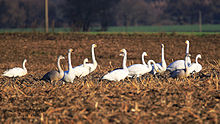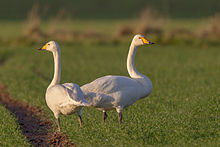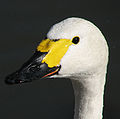Whooper swan
| Whooper swan | ||||||||||||
|---|---|---|---|---|---|---|---|---|---|---|---|---|

Whooper swans in Mecklenburg ( Cygnus cygnus ) |
||||||||||||
| Systematics | ||||||||||||
|
||||||||||||
| Scientific name | ||||||||||||
| Cygnus cygnus | ||||||||||||
| ( Linnaeus , 1758) |
The whooper swan ( Cygnus cygnus ) belongs within the family of duck birds (Anatidae) to the genus of swans ( Cygnus ). At first glance, it differs from the well-known mute swan in that it has a straight neck and a completely different beak.
Whooper swans are breeding birds of the Eastern European and Siberian taiga . These swans can also be observed in Central Europe in autumn and winter. They are regular winter visitors in coastal areas and in the north German lowlands. However, there are also increasing numbers of oversummer and isolated broods in Central Europe. The train from the winter areas starts in October. They return to their breeding grounds from March.
Appearance
Whooper swans reach a size of 145 to 150 cm, a wing length of 59 to 61 cm, a wingspan of almost 200 cm and a weight of 7 to 12 kg. Females are significantly smaller and lighter than males, otherwise whooper swans do not show any noticeable sexual dimorphism .
The plumage of these swans is pure white. The beak is black, the wax skin and base of the beak yellow, and is 9 to 12 cm long. The eyes are just above the base of the beak and are quite small. Unlike the mute swan, the neck is straight and not S-shaped.
The downy cubs are gray-white on top, with the head and neck a little darker. The underside of the body is white. In newly hatched whooper swans, the upper beak is pink and is dark gray with a gray nail at the end. The lower beak is also pink with a gray border. Legs, feet and webbed feet are deeply flesh-colored. In growing whooper swans, the upper beak becomes increasingly pink with a black beak tip. The lower beak turns black. Legs, feet and webbed feet change their color to a rather dark gray-pink. Her iris is dark brown. Young whooper swans have slate-gray plumage, while young birds of the mute swans tend to have brown plumage . The beak of the young whooper swans is still mostly gray-green at this point. In the 1st and 2nd annual dress, the gray youth plumage is gradually replaced by white feathers. The beak turns yellow like spots.
Depending on the season, whooper swans are active both day and night. Outside of the breeding season, they are quite sociable and get along with conspecifics. From October they move to their winter quarters, which stretch along the coasts and large lakes of northern Eurasia . Despite their size, they are extremely good and persistent flyers.
voice
Whooper swans are very call-happy birds with an extensive voice repertoire. A deep, nasal trumpet sound is characteristic of their call. When calling, the neck is usually elongated and the head raised. With their gigigi and the flapping of their wings, the greetings and cries of triumph are reminiscent of the sounds of geese. When whooper swans rest together in larger groups, a faint ang or a throaty ga or go can be heard all the time. The sounds of the individual individuals are different. If they are disturbed, a short and rough uk or ak can be heard from them . During the flight they shout gra gekt or a soft kü kü kü .
In contrast to mute swans, no metallic or whizzing noises can be heard in flight.
distribution
Whooper swans are common in large parts of the subpolar zone of Eurasia. Their distribution area ranges from Iceland to Scandinavia to Siberia . With increasing winter accumulations in Central Europe, not least due to the increased use of rapeseed crops, after several sporadic breeding attempts, a breeding population finally settled far south of the traditional subarctic breeding grounds. Since 1982 whooper swans have been breeding repeatedly in Polish fish ponds. The Free State of Saxony now has eight to ten breeding pairs, in Saxony-Anhalt there have been very successful breeding in the Dieskau Castle Park for years . The population for Germany was given as 21 breeding pairs for 2005, the population trend is classified as increasing.
The whooper swan's natural habitat is usually the barren tundra , which is covered with low vegetation. They live on shallow lakes or slowly flowing waters with rich riparian vegetation. They can be found in fresh, salt and brackish waters. In winter they can also be found in northern Germany . In autumn 2015, over 300 whooper swans stayed in the area northwest of Röbel / Müritz .
food

The diet of whooper swans has a lot in common with that of the mute swan . They mainly feed on aquatic plants. To a lesser extent, they also take in small animals. On land they move surprisingly well and especially eat grass and roots here. In contrast to the mute swan, whooper swans only use agricultural land to a limited extent. They rarely eat winter grain. They are more likely to seek rape cultivation areas.
Reproduction

Sexual maturity is reached at the age of four. The whooper swan's breeding areas are mostly at the level of the Siberian taiga . Lakes of various sizes, alluvial land and shallow rivers are used as nest locations. The breeding season usually begins in April or May. During this time, the swans behave very territorially and bitterly defend their territory against other conspecifics and enemies. The nest is built by the female in dense bank vegetation on the ground. The male brings building material that is built by the female. The nest is padded with down.
The nest is usually at the edge of the water, usually on an island or a headland protruding into the water. In alluvial land it is found on raised land banks. They are single breeders and the nesting site is occasionally used by the same breeding pair for several years.
The female lays five to six yellowish-white to bluish eggs that are approximately 113 x 74 mm in size. The laying interval between the individual eggs is around 48 hours. The female starts brooding after the last egg has been deposited. If the clutch is lost, there is no second clutch. The female incubates the eggs alone over a period of about 35 days. The male watches over the clutch. As a fleeing nest, the chicks follow the mother immediately after hatching. But you will be huffed by her for a long time . Otherwise the young swans are led by both parents. They wear a gray-brown plumage, some of which has a bluish tinge. The beak is flesh-colored and has a black tip like that of the adult birds. The young swans are able to fly after about 90 days. But they stay with their family through the winter. Whooper swans can live to be eight years old, and significantly more in captivity.
Differentiation of different swans
head
neck
Cultural meaning
The whooper swan can sing expressively compared to ordinary swans. The metaphorical identification of the swan with the poet has been derived from this fact since ancient times. So called z. B. Horace Pindar the "Dirkean Swan" ( Carmina IV), a metaphor that was still in use in Goethe's time and can also be found in the German dictionary of the Brothers Grimm . Furthermore, whooper swans are depicted on the Finnish 1 euro coin .
literature
- Hans-Günther Bauer, Einhard Bezzel and Wolfgang Fiedler (eds.): The compendium of birds in Central Europe: Everything about biology, endangerment and protection. Volume 1: Nonpasseriformes - non-sparrow birds. Aula-Verlag, Wiebelsheim 2005, ISBN 3-89104-647-2 .
- Hans-Heiner Bergmann , Hans-Wolfgang Helb , Sabine Baumann: The voices of the birds of Europe. 474 bird portraits with 914 calls and chants on 2,200 sonograms. Aula-Verlag, Wiebelsheim 2008, ISBN 978-3-89104-710-1 .
- T. Bartlett: Ducks and Geese. A guide to management. The Crowood Press 2002, Ramsbury. ISBN 1-852236507 .
- Hartmut Kolbe: The world's ducks. Ulmer Verlag, Stuttgart 1999. ISBN 3-8001-7442-1 .
Web links
- Cygnus Cygnus in the endangered Red List species the IUCN 2008. Posted by: BirdLife International, 2008. Accessed January 31 of 2009.
- Videos, photos and sound recordings of Cygnus cygnus in the Internet Bird Collection
Individual evidence
- ↑ Bergmann et al., P. 34.
- ↑ Saxon State Office for Environment and Geology (ed.): Wild geese and swans in Saxony - occurrence, behavior and management , Dresden 2006, publication as part of the public relations work of the Saxon State Office for Environment and Geology, p. 16.
- ↑ a b Kolbe, p. 96.
- ↑ Bergmann et al., P. 34. The onomatopoeic descriptions of the sounds are taken from Bergmann.
- ↑ Bauer et al., P. 44.
- ↑ Saxon State Office for Environment and Geology (Hg): Wild geese and swans in Saxony - occurrence, behavior and management , Dresden 2006, publication in the context of the public relations work of the Saxon State Office for Environment and Geology, p. 6
- ^ NABU Regional Association Halle-Saalekreis e. V. Newsletter 01/2020, page 3
- ↑ Sudfeldt, C., R. Dröschmeister, M. Flade, C. Grüneberg, A. Mitschke, J. Schwarz, J. Wahl: Vögel in Deutschland - 2009 . DDA, BfN, LAG VSW, Münster 2009.
- ↑ Frank Liebig, veterinarian i. R., Röbel
- ↑ Saxon State Office for Environment and Geology (Ed.): Wild geese and swans in Saxony - occurrence, behavior and management , Dresden 2006, publication in the context of public relations work by the Saxon State Office for Environment and Geology, p. 26.
- ↑ a b c Collin Harrison, Peter Castell: Field Guide Bird Nests, Eggs and Nestlings , HarperCollins Publisher, revised edition from 2002, p. 62. ISBN 0007130392








